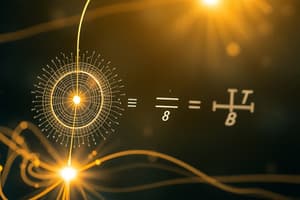Podcast
Questions and Answers
What is the characteristic of diamagnetic materials when a magnetic field is applied?
What is the characteristic of diamagnetic materials when a magnetic field is applied?
- The material develops a permanent magnetic dipole moment.
- The material's magnetic dipole moment and force remain unchanged.
- The material develops a magnetic dipole moment and experiences a magnetic force. (correct)
- The material's magnetic dipole moment and force increase exponentially.
According to Curie's law, what is the relationship between the magnetization M of a paramagnetic sample and the external magnetic field Bext?
According to Curie's law, what is the relationship between the magnetization M of a paramagnetic sample and the external magnetic field Bext?
- M is proportional to the square root of Bext
- M is directly proportional to Bext (correct)
- M is inversely proportional to Bext
- M is independent of Bext
What is the effect of increasing temperature T on the magnetization M of a paramagnetic sample?
What is the effect of increasing temperature T on the magnetization M of a paramagnetic sample?
- M becomes zero
- M remains constant
- M increases
- M decreases (correct)
What is the reason for the persistent alignment of magnetic dipole moments in ferromagnetic materials?
What is the reason for the persistent alignment of magnetic dipole moments in ferromagnetic materials?
What happens to the magnetic dipole moments of diamagnetic materials when the external magnetic field is removed?
What happens to the magnetic dipole moments of diamagnetic materials when the external magnetic field is removed?
What is the term for the ratio of the magnetic dipole moment to the volume V of a sample?
What is the term for the ratio of the magnetic dipole moment to the volume V of a sample?
Which type of material exhibits permanent magnetism due to the alignment of magnetic dipole moments?
Which type of material exhibits permanent magnetism due to the alignment of magnetic dipole moments?
What is the effect of increasing the external magnetic field Bext on the magnetization M of a paramagnetic sample, according to Curie's law?
What is the effect of increasing the external magnetic field Bext on the magnetization M of a paramagnetic sample, according to Curie's law?
What is the condition for Curie's law to be valid?
What is the condition for Curie's law to be valid?
What is the result of exchange coupling in ferromagnetic materials?
What is the result of exchange coupling in ferromagnetic materials?
Flashcards are hidden until you start studying
Study Notes
Maxwell's Equations and Magnetism
- Gauss's Law for Magnetic Fields: The net magnetic flux through any closed Gaussian surface is zero, where B is the magnetic field.
- The law holds even if the Gaussian surface does not enclose the entire structure.
- A magnetic dipole is enclosed by a Gaussian surface, and the net flux through the surface is zero.
Induced Magnetic Fields
- The magnetic field induced along a closed loop by a changing electric flux FE in the region encircled by that loop.
- The magnetic field induced by a changing electric field is shown at four points on a circle with a radius less than the plate radius.
- Ampere-Maxwell Law: ∇ × B = μ₀(ienc + ε₀∂E/∂t), where ienc is the current encircled by the closed loop.
Displacement Current
- The product of the electric field and the area of the plates of a parallel plate capacitor has the dimension of a current.
- The displacement current id is a fictitious current that is encircled by the integration loop.
- The magnetic field induced by a changing electric field is related to the displacement current.
Maxwell's Equations
- A set of equations that describe the relationships between electric and magnetic fields.
Magnetism of Earth
- Earth's magnetic field is that of a magnetic dipole, with a magnetic dipole moment m.
- The field declination is the angle between geographic north and the horizontal component of the field.
- The field inclination is the angle between a horizontal plane and the field's direction.
Magnetism and Electrons
- An electron has an intrinsic angular momentum called its spin angular momentum, and an intrinsic spin magnetic dipole moment.
- The orientation energy for the electron in an external magnetic field is related to its spin magnetic dipole moment.
- An electron in an atom has an orbital magnetic dipole moment, which is related to its orbital angular momentum.
- The orientation energy is quantized, with only certain components allowed.
Magnetic Materials
- Each electron in an atom has an orbital and spin magnetic dipole moment, which combines to produce a magnetic field in a material.
- There are three general types of magnetism: diamagnetism, paramagnetism, and ferromagnetism.
- Diamagnetism: Weak magnetic dipole moments are produced in the atoms of a material when it is placed in an external magnetic field.
- Paramagnetism: Each atom has a permanent resultant magnetic dipole moment, but the moments are randomly oriented, and the material lacks a net magnetic field.
- Ferromagnetism: Some electrons have their resultant magnetic dipole moments aligned, producing regions with strong magnetic dipole moments.
Diamagnetism
- A diamagnetic material develops a magnetic dipole moment and experiences a magnetic force when a magnetic field is applied.
- When the field is removed, both the dipole moment and the force disappear.
Paramagnetism
- The magnetization M of a paramagnetic sample is directly proportional to the magnitude of the external magnetic field and inversely proportional to the temperature.
- Curie's Law: M = CBext/T, where C is the Curie constant.
Ferromagnetism
- Exchange coupling is a quantum physical effect that causes alignment of the magnetic dipole moments of atoms in ferromagnetic materials.
- This alignment is what gives ferromagnetic materials their permanent magnetism.
Studying That Suits You
Use AI to generate personalized quizzes and flashcards to suit your learning preferences.




